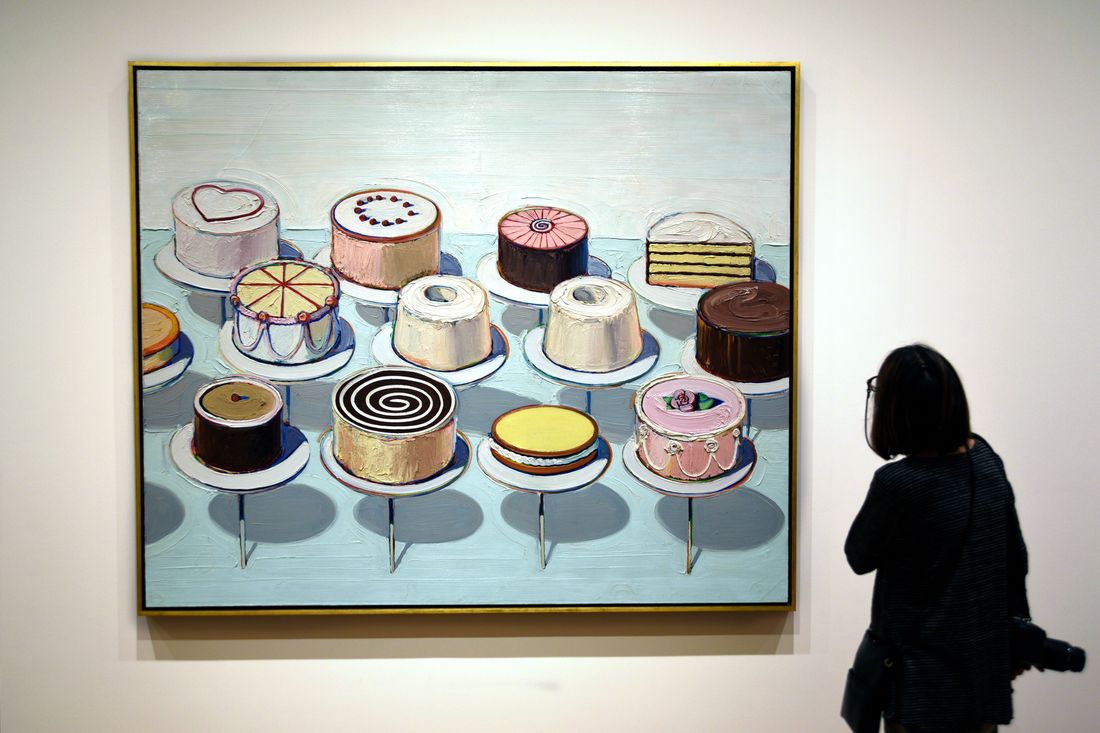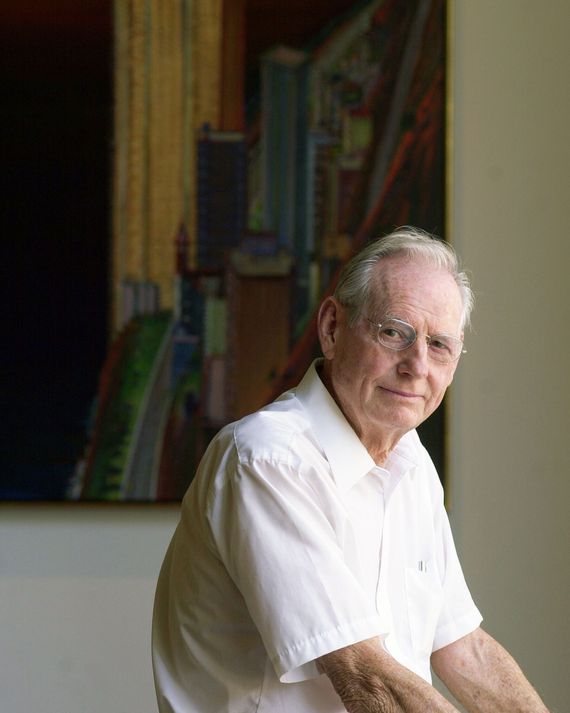
Wayne Thiebaud’s paintings of cakes, bathers, landscapes, paint cans, pastries, and cityscapes represent a luscious American sublime.
Calling him a “California painter,” as many do, would be like calling Albert Pinkham Ryder a “New York painter.” Thiebaud’s work is universal. His hallucinatory surfaces, uncanny perceptual intelligence, thick buildups of rich color, hard light, luminosity, tonal control, and Hopperesque remove create eye-worms that make you meld with the paintings, participate in how they were made. Following brushstrokes, lulled from surface to surface, you experience a release of internal rapture from form.
Thiebaud was born in Arizona and lived for a time in New York, where he tried to shop his illustrations and commercial art; knew de Kooning, Kline, Guston, and Barnett Newman; and was taken by the new energies in artists like Jasper Johns and Robert Rauschenberg. That both were younger than him tells you he wasn’t stuck in any ideological aesthetic rut. He spent nearly the entirety of his 101 years in California, specifically in Sacramento. There, he taught at UC Davis. (Bruce Nauman was his student.) At this distance from New York, sifting through a raft of influences and art history with one of the most distinctive optical styles in all of American painting, Thiebaud synthesized Pop Art’s everyday commodity culture, strong color, ironies, and commercial realism. He combined this with the painterly West Coast figuration of his peers like David Park, the abstraction of Richard Diebenkorn, and the materiality of ceramicists like Peter Voulkos and Robert Arneson. To this he added the formalism and oddity of Morandi’s still lifes, the intimacies of Chardin, and techniques of the old masters. He told students who didn’t want to learn these, “It would be great if you could make a brilliant end run around all that stuff, but with painting there’s no such thing …”
I met him, once, when I lectured in the 1990s at UC Davis. He sat in the front row. Until that moment, however, I’d never really thought about his work much. I respected it. But it felt off to one side, not as edgy or relevant to the moment as someone around his age, who also painted in California, and in his own colorful idiom: David Hockney. No matter. I showed slides of emerging artists like Matthew Barney, Janine Antoni, Chris Ofili, Kara Walker, Robert Gober, and Jeff Koons, and he was rapt. Afterward, he told me he felt this work in his nerves and muscles. He asked if I would like to play tennis with him (he played his whole life). I am sorry I didn’t.
How we see was paramount to Thiebaud. He told the New York Times, “I don’t agree with Duchamp that the eye is a dumb organ … I think the eye has a mind of its own and there are different ways we see. There’s peripheral vision, the myopic close-up sensation, focused seeing,” and went on to list the glance, stare, squint, and closed-eye daydreaming. “The more ways you can put together in a picture … the richer it becomes, the more like life.” He is most widely known for his juicy pictures of voluptuous confectionary in shop displays and on countertops. It’s an eternal dinner in these works. See the edges of objects wobble, come in and out of focus, flowing one into another, all in this strong graphic field that releases dopamine rushes of pleasure. These are the things of dorm-room posters and fridge magnets and made him immensely popular. His work sold for millions.
The works that pull the rug out from under me are his cities and landscapes. Here, Thiebaud unleashes his visionary powers. Gaping holes open in space as city streets in rows and houses and on hills recede into infinity but force their way back to the surface of the work. Soon there’s no space here at all. It’s an American version of a Chinese landscape where you see vast distances and single trees at the same time and the work turns into a cloud. Nothing stays put; everything is amorphous, molten, forming. Geometric shapes reform before your eyes into textured pavement, orange trees, and shadows that always tell you the time of day. His paintings are sundials. His worlds are populous, lived in, but always empty. We are lost in time, suspended in deserted cities and the California noir of Raymond Chandler.
Then there are his landscapes, my favorite of all. These wetlands, undulating causeways, planted crops, rows of fences, pear-shaped aqueducts are rendered in this trustful equanimity. He only painted tamed, man-made landscapes, but he released something feral within them. And us.
I hated him for these works. No, not really — I was just jealous. It never rains in a Thiebaud painting. The darkest day he ever painted was only partly sunny. He is a master of scorched sunlight and sapphire watery blues. Even his indoor scenes have the outside pouring in, keeping you alive, in awe, surrounded by and part of nature. As a son of Chicago and the Great Lakes, a New Yorker for the last 40 years, I look at these paintings with longing. I have never lived in year-round light, warmth, and the outdoors. All my fantasies of places I will never live come to me: Los Angeles, Spain, Arizona, Italy, the Caribbean, Mexico. I become nostalgic for things I will never know. Henry James wrote of California and “the general aspect of that wondrous realm [that] kept suggesting to me a sort of prepared but unconscious and unexpected Italy … in perfect condition, but with the impression of history all yet to be made.” Thiebaud’s art is that for me, an unwinding book of hours that reveals a stilled state of mind, something inexhaustible, internal, beckoning, and resilient.





